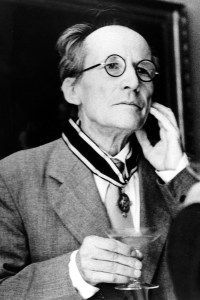Today’s Google Doodle celebrates the life of Austrian physicist and Nobel Prize winner Erwin Schrödinger (August 12, 1887 — January 4, 1961), a founder of quantum physics who used cats to explain things long before Internet cat videos became cool.
(LIST: A History of Google Doodles)

AUSTRIA – AUGUST 28: Erwin Schrodinger (1887-1961) founded wave mechanics, creating Schrodinger’s equation.
The cats in the Google Doodle illustrate his famous thought experiment known as “Schrödinger’s Cat,” proposed to help explain quantum mechanics. As TIME sums up the theory:
Put a cat in a box, he proposed, and rig up a Rube Goldberg contraption involving a hammer, a vial of poison and a quantum triggering device. If an electron is in one position, the hammer will remain safely cocked. But if the electron moves into the opposite location, the hammer will drop, smashing the vial and killing the cat.
The laws of quantum mechanics hold that as long as the electron remains undisturbed, it hangs in limbo, occupying both its possible states. The cat, by extension, is both dead and alive.
This animated cat video also explains everything you need to know in under two minutes:
[youtube=http://www.youtube.com/watch?v=IOYyCHGWJq4]
A native of Vienna, Austria, who worked for a brief time alongside Albert Einstein, Schrödinger also developed what is called Schrödinger’s wave equation — an important discovery in the field of wave mechanics for which he shared the 1933 Nobel Prize for Physics with British physicist P.A.M. Dirac. In a 1933 article about the prizewinners, TIME wrote that Schrödinger expanded the field of subatomic study:
“He replaced the classical equations for electron motion with new differential equations similar to those which describe the wave motion which constitutes light and sound. Thus the atom is conceived as a positive nucleus wrapped in a throbbing field of negative electricity.”
Schrödinger also penned What Is Life? (first published in 1944), which “argued that one of life’s essential features is the storage and transmission of information–that is, a genetic code that passes from parent to child,” TIME wrote in 2003.
When the physicist was not coming up with ground-breaking science, he liked to “ski, skate, swim, climb mountains,” TIME reported. He died from tuberculosis in 1961.
Google Doodles have been paying tribute to great scientists and scientific causes recently, including Maria Mitchell, the first professional astronomer in the U.S. and the biophysicist Rosalind Franklin, whose x-rays helped reveal DNA’s double-helix structure.
MORE: Google Doodle Honors Maria Mitchell, First Professional Woman Astronomer in the U.S.






